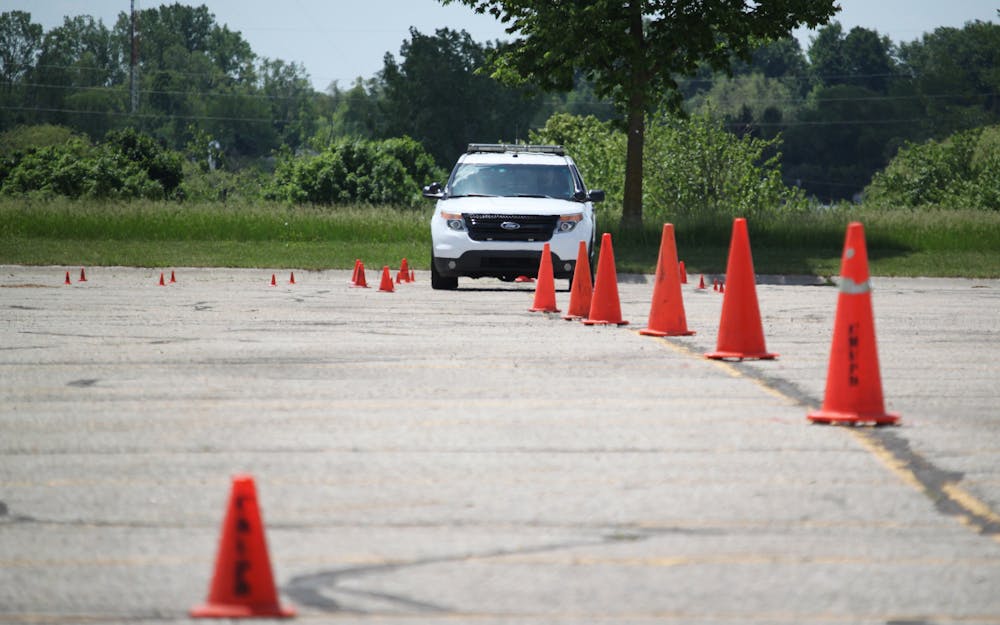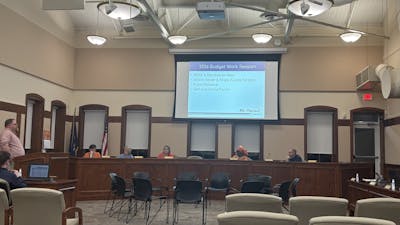Training day
CMU Police road officers undergo recertification

Central Michigan University Community Police Officer Josh Chapman prepares to navigate the serpentine test Thursday, May 23, in Lot 63 adjacent to Kelly/Shorts stadium. During the drill, officers have to drive a serpentine through the road cones at 35 mph, come to a stop at a designated area, and reverse through the same pattern, without hitting or knocking over a cone.
On a straight road with well-defined lanes, a clear sight line and no major obstacles, 35 mph may not seem like that fast of a driving speed.
But in a Ford Explorer Police Interceptor, in a parking lot beset with orange road cones, with the stress of recertification on the line, and with only about 10 yards to slow and slam the vehicle into a 90-degree left-hand turn without locking up the breaks or knocking into something, that speed can seem breathtakingly fast.
It was just one of four obstacles a dozen Central Michigan University Police road patrol officers undertook this week. The pavement in Lot 63 just outside of Kelly/Shorts Stadium bore the skid marks of burned rubber and echoed with the sound of squealing tires Thursday, as two officers and as many command sergeants undertook their biannual tactical driving skills recertification.
In addition to the high-speed turn maneuver, the officers had to successfully navigate a serpentine pattern forward, come to a complete halt, throw the vehicle into reverse and negotiate the same pattern backward; master a parking strategy known as “the garage,” in which they backed the SUV from one narrow spot into another while negotiating a 90-degree turn; and perform a pair of defensive evasion maneuvers that saw them making hard turns at the last minute.
All at an average forward speed of 35 mph and without knocking over road cones spaced little more than a car length apart.
“These vehicles are the number one piece of equipment we use,” said Detective Scott Bailey, the department’s evasive vehicle operations trainer and testing officer. “There are a ton of distractions in these cars.”
Bailey gestured around the cab of the testing vehicle known to the team by the number on its front fender – 6-3. Inside, a dispatch scanner crackled, the dashboard cam kept its unblinking eye on the road, and a department-issued laptop sat on a secure platform over much of the front passenger seat. It’s standard equipment for the department’s marked vehicles.
Add a potentially unruly suspect to the back seat, the stressors of a high-intensity moment or call, and the endless influence of every-day technology, and it’s important to know the officers are prepared to respond with quick reflexes, intuition and a well of defensive tactics.
As the four squad members undertaking the training Thursday – Community Police Officer Josh Chapman, Officer Mark Smoker, Sgt. Ryan Roost and Sgt. Jeff Ballard -- careened, sped and cruised their way through the exam, Bailey sat in the front seat, arm casually out the window, providing feedback and last-minute instructions. He went through the drills with a dozen officers that week.
Smoker, after completing his test, stood on a grassy berm watching his colleagues drive. A 35-year policing veteran, he has spent more than two decades of his career on CMU’s campus, and he said emerging technology and changes to how we get around – such as the increased use of micro-mobility devices like electric scooters – have impacted the rules of the road.
“There’s just so many more factors that can cause a bad situation,” he said. “On campus, it’s … incumbent on you to drive slowly and pay attention to what’s going on because there’s a lot to notice.”
While the odds of a high-speed chase here may not be great, the possibility of a distracted driver or pedestrian causing an issue are. These re-certification process, Smoker said, keeps officers sharp.
“It tests your skills, tests your reflexes and how you correct” an issue, he said.






